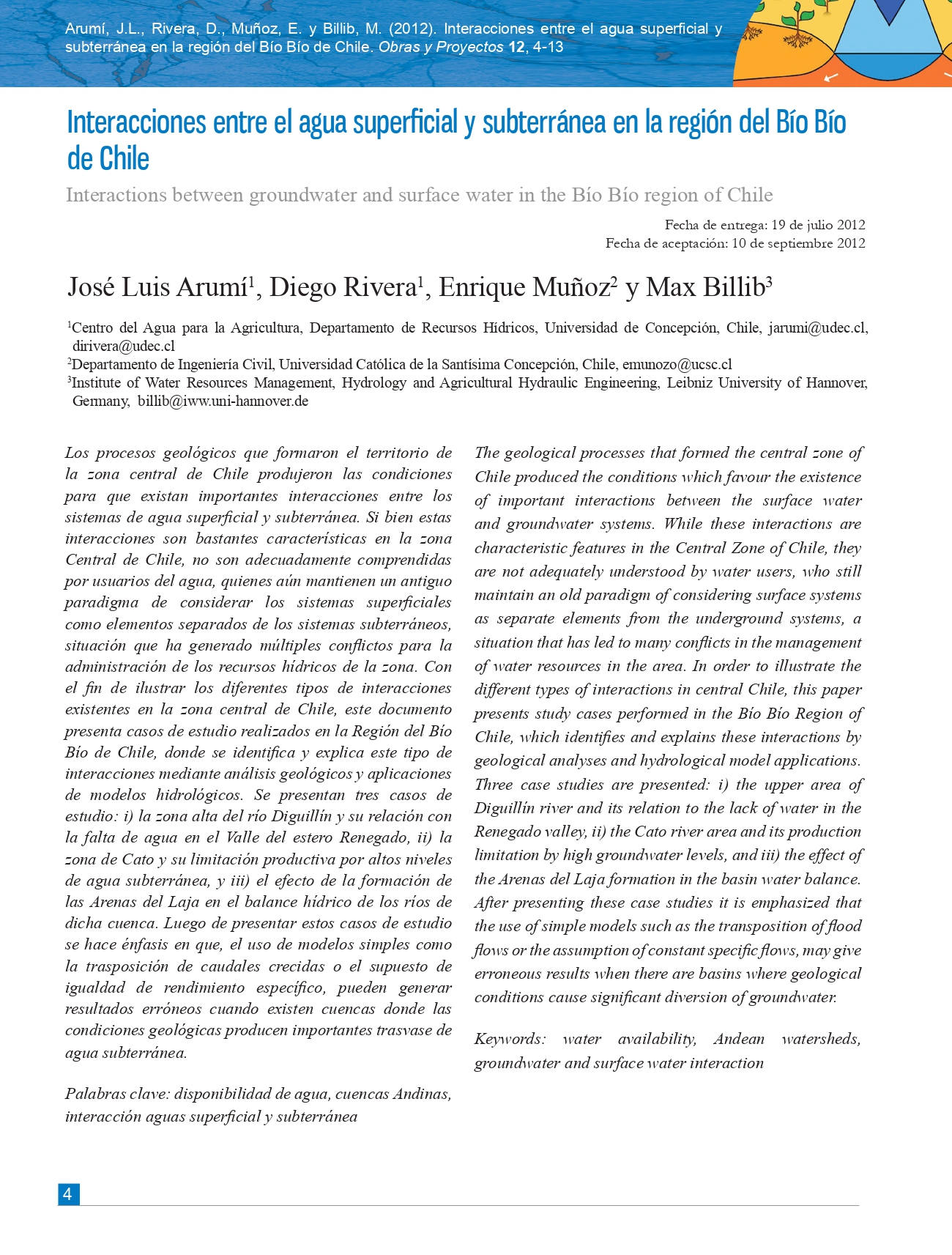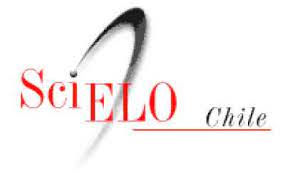Interactions between groundwater and surface water in the Bío Bío region of Chile
DOI:
https://doi.org/10.4067/S0718-28132012000200001Keywords:
water availability, Andean watersheds, groundwater and surface water interactionAbstract
The geological processes that formed the central zone of Chile produced the conditions which favour the existence of important interactions between the surface water and groundwater systems. While these interactions are characteristic features in the Central Zone of Chile, they are not adequately understood by water users, who still maintain an old paradigm of considering surface systems as separate elements from the underground systems, a situation that has led to many conflicts in the management of water resources in the area. In order to illustrate the different types of interactions in central Chile, this paper presents study cases performed in the Bío Bío Region of Chile, which identifies and explains these interactions by geological analyses and hydrological model applications. Three case studies are presented: i) the upper area of Diguillín river and its relation to the lack of water in the Renegado valley, ii) the Cato river area and its production limitation by high groundwater levels, and iii) the effect of the Arenas del Laja formation in the basin water balance. After presenting these case studies it is emphasized that the use of simple models such as the transposition offlood flows or the assumption ofconstant specificflows, may give erroneous results when there are basins where geological conditions cause significant diversion of groundwater.
References
Arumí, J.L. y Oyarzún, R A. (2006). Las Aguas Subterráneas en Chile. Boletín Geológico y Minero (IGME) 117(1), 37-45.
Arumí, J.L., Rivera, D., Rougier, A. y Díaz, R. (2012). Estimación de pérdidas de agua en tramos de ríos del sistema Laja-Diguillín en la zona central de Chile. Tecnología y Ciencias del Agua 3, 135-141.
Bencala, K.E. (2011). Stream-Groundwater Interactions. In: Peter Wilderer (ed.) Treatise on Water Science 2, 537-546, Oxford Academic Press.
Bencala, K.E., Gooseff, M.N. and Kimball, B.A. (2011). Rethinking hyporheic flow and transient storage to advance understanding of stream-catchment connections. Water Resources Research 47, W00H03. https://doi.org/10.1029/2010WR010066
Borgell, R. (1983). Geografía de Chile, Tomo II: Geomorfología. Instituto Geográfico Militar. Santiago, Chile.
Carling, T, Mayo, A.L., Tingey, D. and Bruthans, J. (2012). Mechanisms, timing, and rates of arid region mountain front recharge. Journal ofHydrology 428-429, 15-31. https://doi.org/10.1016/j.jhydrol.2011.12.043
Cembrano, J., Lavenu, A., Yañez, G., Riquelme, R., García, M., González, G. and Hérail, G. (2007). Neotectonics. In The Geology of Chile. Moreno and Gibbons eds. The Geological Society of London
Cirmo, C.P. and McDonnell, J.J. (1997). Linking the hydrologic and biogeochemical controls of nitrogen transport in near-stream zones of temperate-forested catchments: a review. Journal of Hydrology 199(1-2), 88-120. https://doi.org/10.1016/S0022-1694(96)03286-6
Delleur, J.W. (1999). The Handbook of Groundwater Engineering. CRC Press. Boca Raton. Florida.
DGA. (2011). Estudio hidrogeológico cuencas Bío Bío e Itata. Dirección General de Aguas, División de Estudios y Planificación, Aquaterra Ingenieros Ltda.
Dixon, H., Murphy, M., Sparks, S., Chávez, R., Naranjo, J., Dunkley, P., Young, S., Gilbert, J. and Pringle, M. (1999). The geology of Nevados de Chillán volcano, Chile. Revista Geológica de Chile 26(2), 227-253. https://doi.org/10.4067/S0716-02081999000200006
Fernald, A. (2002). Groundwater/Surface Water Interactions. New Mexico Annual Water Conference Proceedings. WRRI: 46th Proceedings, 323, 49-57.
Garreaud, R.D., Vuille, M., Compagnucci, R. and Marengo, J. (2009). Present-day South American climate. Palaeogeography, Palaeoclimatology, Palaeoecology 281(3), 180-195. https://doi.org/10.1016/j.palaeo.2007.10.032
Hinkle, S.R., Duff, J.H., Triska, F.J., Laenen, A., Gates, E.B., Bencala, K.E., Wentz, D.A. and Silva, S.R. (2001). Linking hyporheic flow and nitrogen cycling near the Willamette River - a large river in Oregon, USA. Journal ofHydrology 244(3-4), 157-180. https://doi.org/10.1016/S0022-1694(01)00335-3
Jonsson, K., Johansson, H. and Worman A. (2003). Hyporheic exchange of reactive and conservative solutes in streams—tracer methodology and model interpretation. Journal of Hydrology 278(1-4), 153-171. https://doi.org/10.1016/S0022-1694(03)00140-9
Moreno, H. y Varela, J. (1985). Geología, volcanismo y sedimentos piroclásticos cuaternarios de la Región Central y Sur de Chile. Suelos volcánicos de Chile. J. Tosso, ed., Instituto de Investigaciones Agropecuarias, Ministerio de Agricultura, Chile, 491-526.
Muñoz, E. (2010). Desarrollo de un modelo hidrológico como herramienta de apoyo para la gestión del agua. Aplicación a la cuenca del río Laja, Chile. Tesis Master, Departamento de Ciencias y Técnicas del Agua y del Medio Ambiente, Universidad de Cantabria, España.
Muñoz, E., Álvarez, C., Billib, M., Arumí, J.L. and Rivera, D. (2011). Comparison of gridded and measured rainfall data for hydrological studies at basin scale. Chilean Journal of Agricultural Research 7(3), 459-468. https://doi.org/10.4067/S0718-58392011000300018
Naranjo, J.A., Gilbert, J. y Sparks, R.S. (2008). Geología del complejo volcánico Nevados de Chillán, Región del Bío Bío. Servicio Nacional de Geología y Minería, Carta Geológica de Chile, Serie Geología Básica 114, 28pp.
NASA (2005). Shuttle Radar Topography Mission (SRTM) [en línea] http://www2.jpl.nasa.gov/srtm/
Peckenpaugh, J.M. and Dugan, J.T. (1983). Hydrogeology of parts of the Central Platte and Lower Loup Natural Resources Districts. Nebraska. U.S. Geological Survey Water-Resources Investigation. Report 83-4219, 100 pp. https://doi.org/10.3133/wri834219
Prisma (2004). Plan Maestro de Manejo de Cauces Cuenca del Río Chillán, VIII Región. Santiago, Chile.
ProItata (1992). Proyecto Itata, Estudio Hidrológico y Situación Actual Agropecuaria. Comisión Nacional de Riego, Santiago, Chile.
Rango, A. and Martinec, J. (1995). Revisiting the degree-day method for snowmelt computations. Journal of the American Water Resources Association 31(4), 657-669. https://doi.org/10.1111/j.1752-1688.1995.tb03392.x
Singh, V.P. (1995). Computer models of watershed hydrology. Water Resources Publications.
Sophocleous, M. (2002). Interaction between groundwater and surface water: The state of the Science. Hydrogeology Journal 10, 52-67. https://doi.org/10.1007/s10040-001-0170-8
Thiele, R., Moreno, H., Elgueta, S., Lahsen, A., Rebolledo, S. y Petit-Breuilh, M.E. (1998). Evolución geológico-geomorfológica cuaternaria del tramo superior del valle del río Laja. Revista Geológica de Chile 25(2), 229-253. https://doi.org/10.4067/S0716-02081998000200007
Winter, T.C., Harvey, J.W., Franke, O.L. and Alley, W.M. (1998). Ground Water and Surface Water a Single Resource. U.S. Geological Survey Circular 1139. Denver Colorado. https://doi.org/10.3133/cir1139
Woessner, W.W. (2000). Stream and fluvial plain groundwater interactions: rescaling hydrogeologic thought. Ground Water 38(3), 423-429. https://doi.org/10.1111/j.1745-6584.2000.tb00228.x
Zúñiga, R., Muñoz, E. y Arumí, J.L. (2012). Estudio de los Procesos Hidrológicos de la cuenca del Río Diguillín. Obras y Proyectos 11, 69-78. https://doi.org/10.4067/S0718-28132012000100007

Downloads
Published
Issue
Section
License
Copyright (c) 2012 Universidad Católica de la Santísima Concepción

This work is licensed under a Creative Commons Attribution-NonCommercial 4.0 International License.







